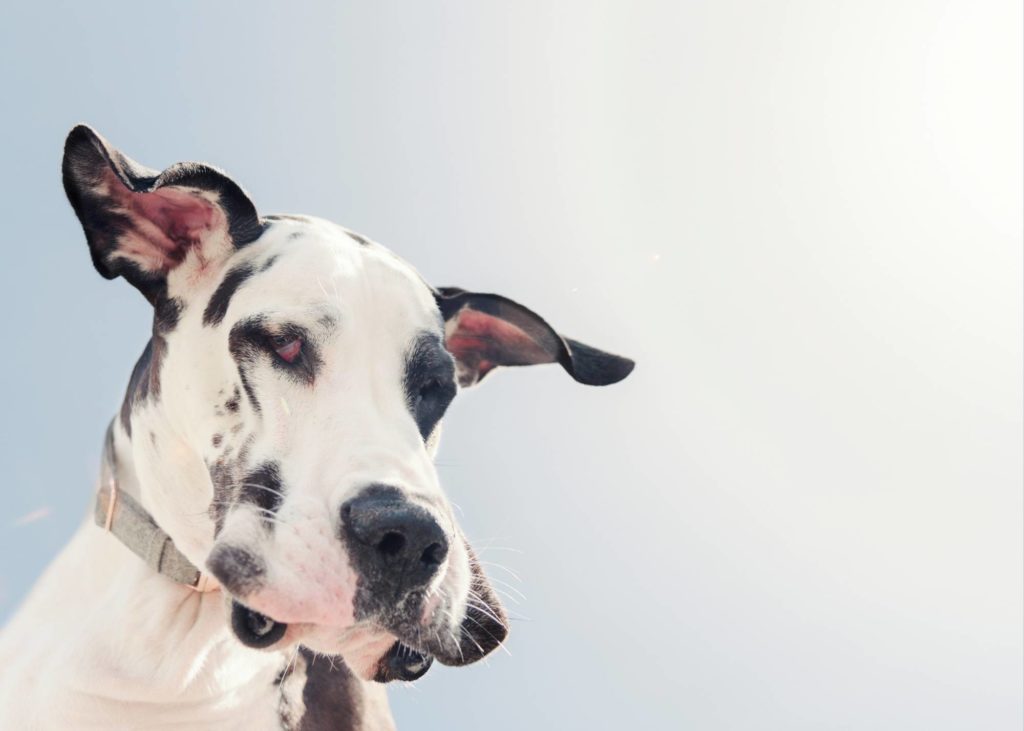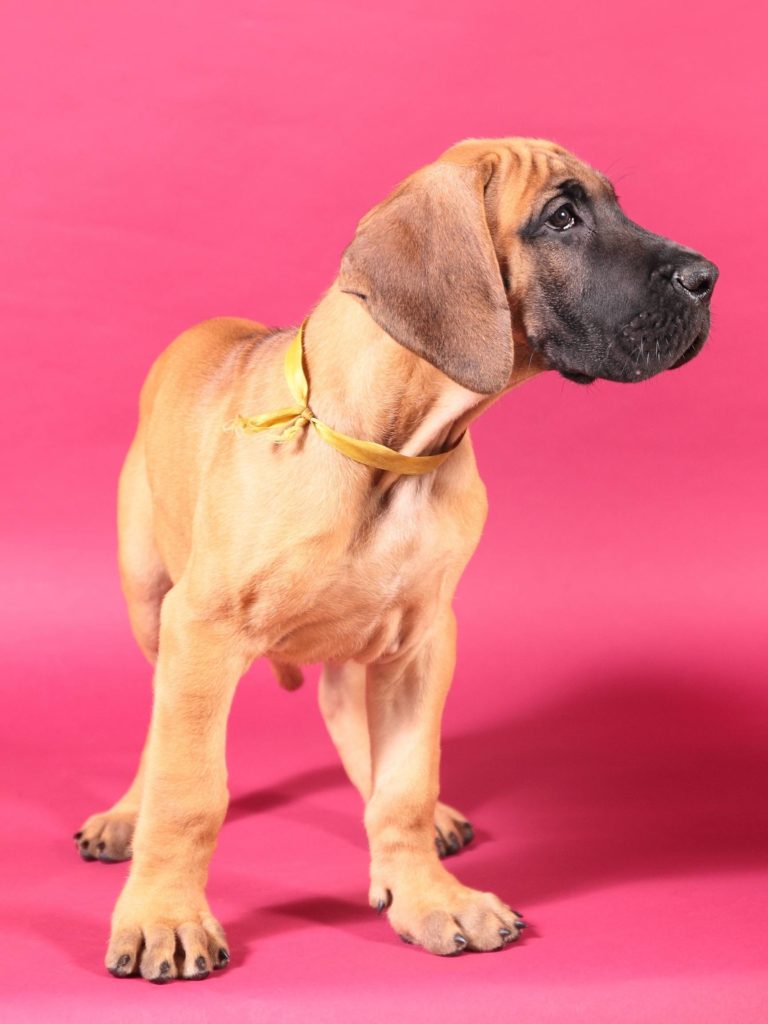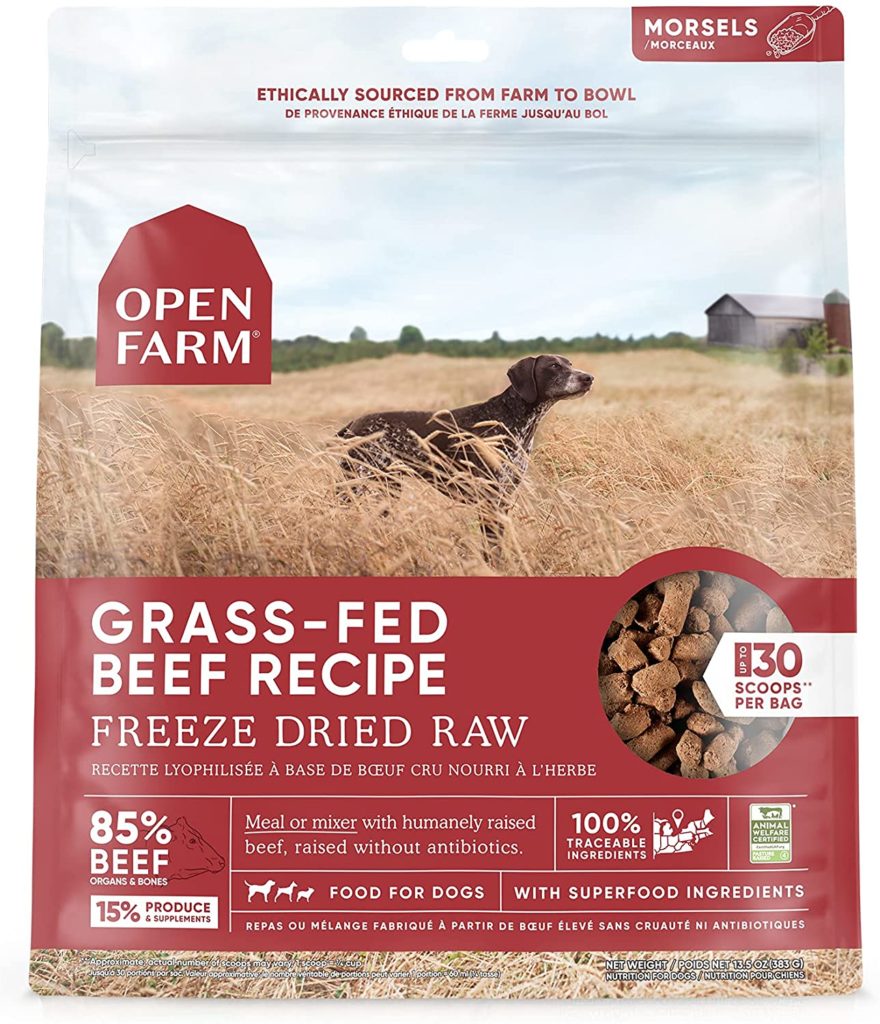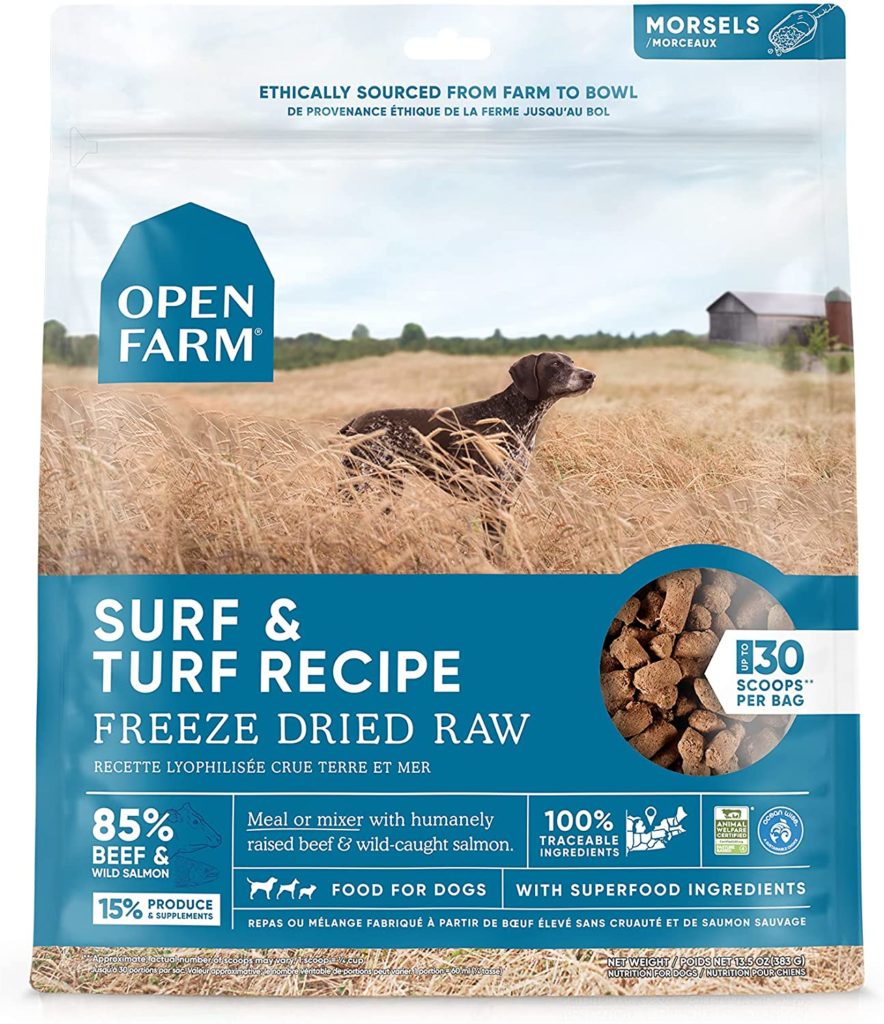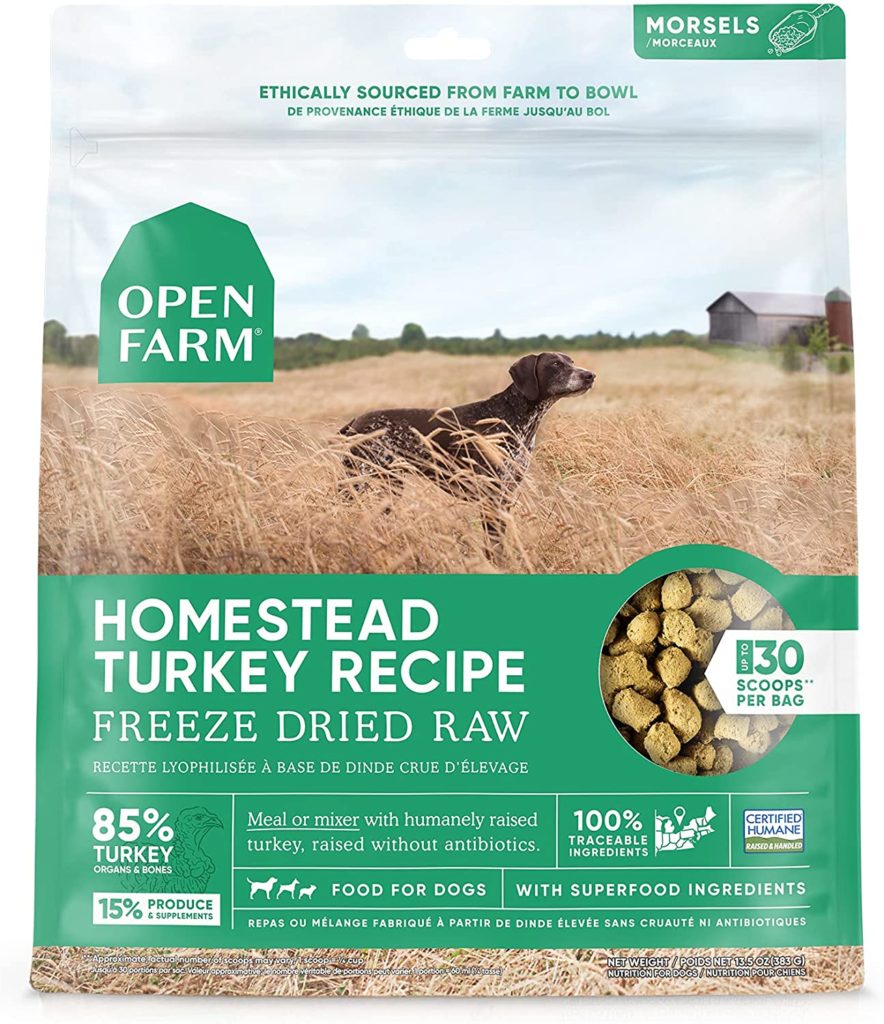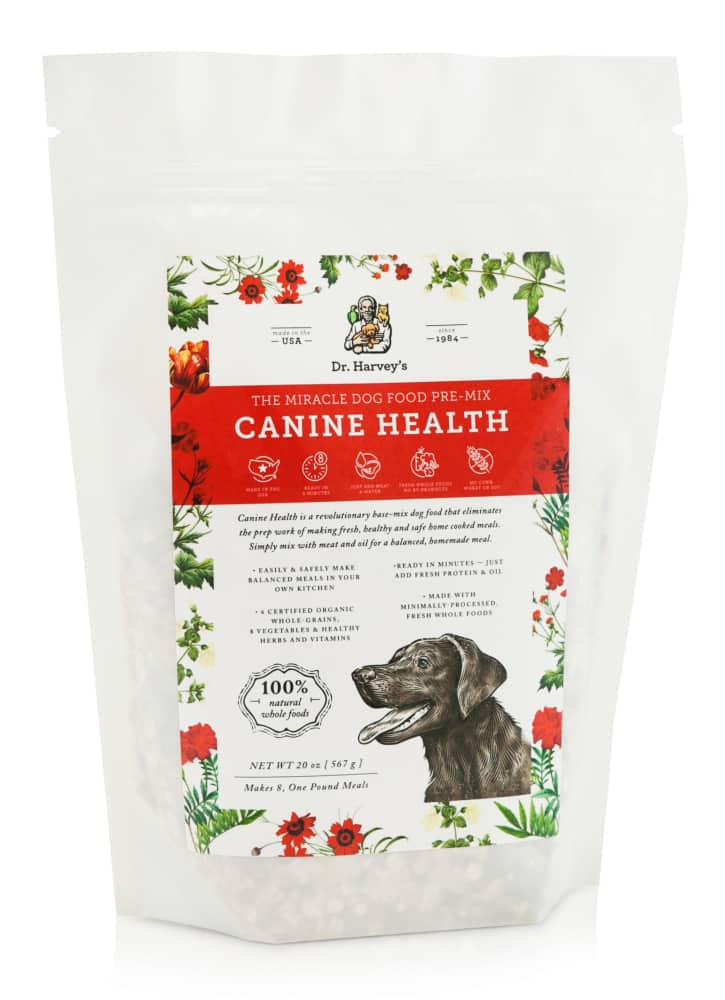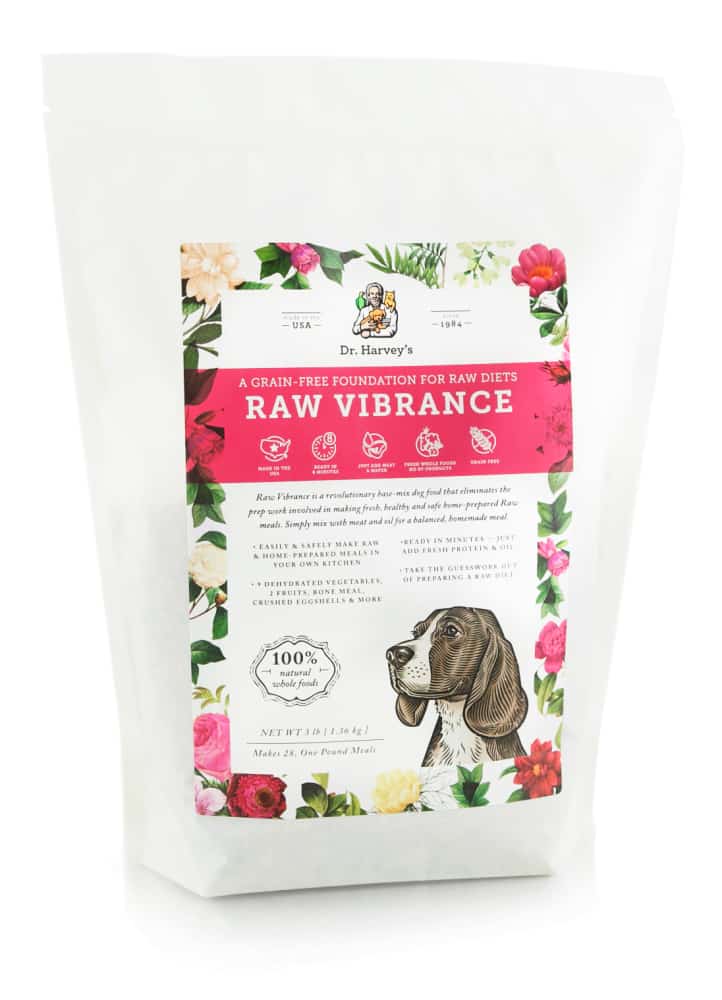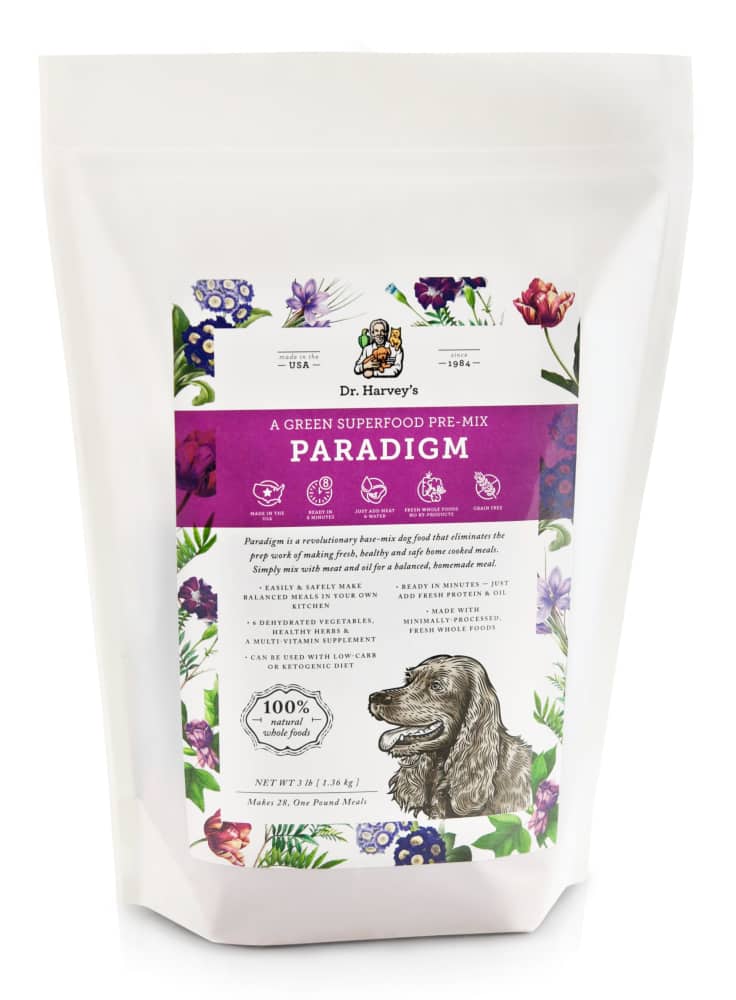Do you have a hard time knowing how much food to give your dog? Are you afraid of overfeeding them and making them obese? Or are you in the dark about how much food you really should be feeding your dog?
We are here to help. Chances are, you may actually be OVERFEEDING your dog!
Is your Great Dane struggling with pickiness and loose stools? Yeah, about that. We’ll cover it, too.
In this blog post, we will discuss how to use a scale to measure your dog’s food and make sure they are getting the right amount. This is an important step in ensuring their health and wellbeing.
Using a scale to measure your dog food can also save you money, resolve chronic loose stools, and put pickiness to bed, once and for all.
Read on, friends!
Stop Overfeeding Your Dog
Here is our table of contents. The headings are clickable for navigation!
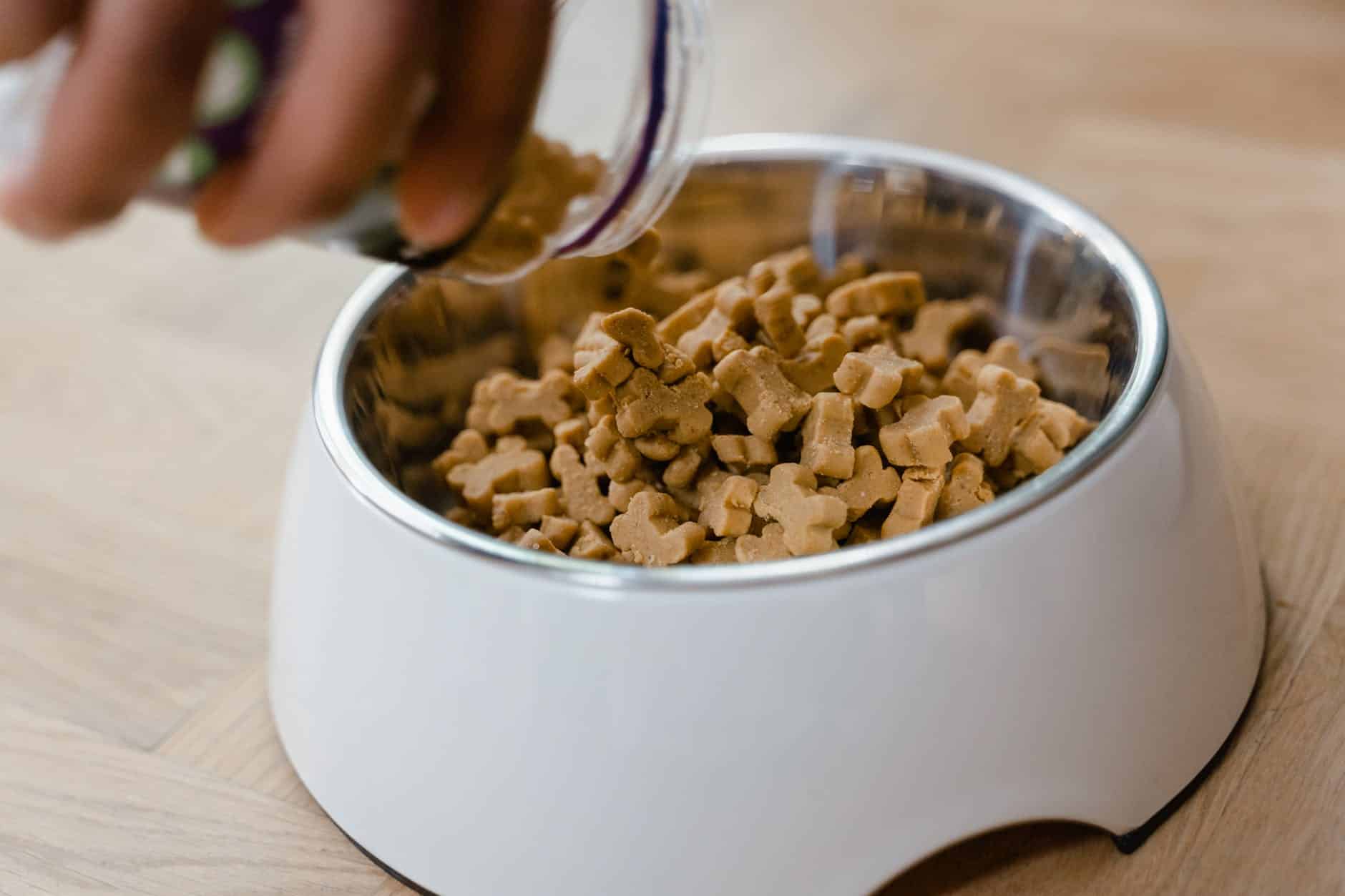
Step One: Read the Kibble Bag…
Responsible dog food companies will give you grams per cup and kilocalories per cup measurements right on the bag.
Every food company will be different!
| Brand | KCALS/CUP | Grams Per Cup |
| Royal Canin Giant Breed Adult | 337 | 108 |
| Pro Plan Large Breed Shredded Chicken | 353 | 96 |
As you can see here, the actual weight of the food and the nutrition per cup can vary!
A cup of dog food is not the same as a cup of dog food from a different bag, in other words.
Pro Tip: this is a good reason to use the food chart on the back of the bag for reference, not necessarily generic Great Dane feeding charts!
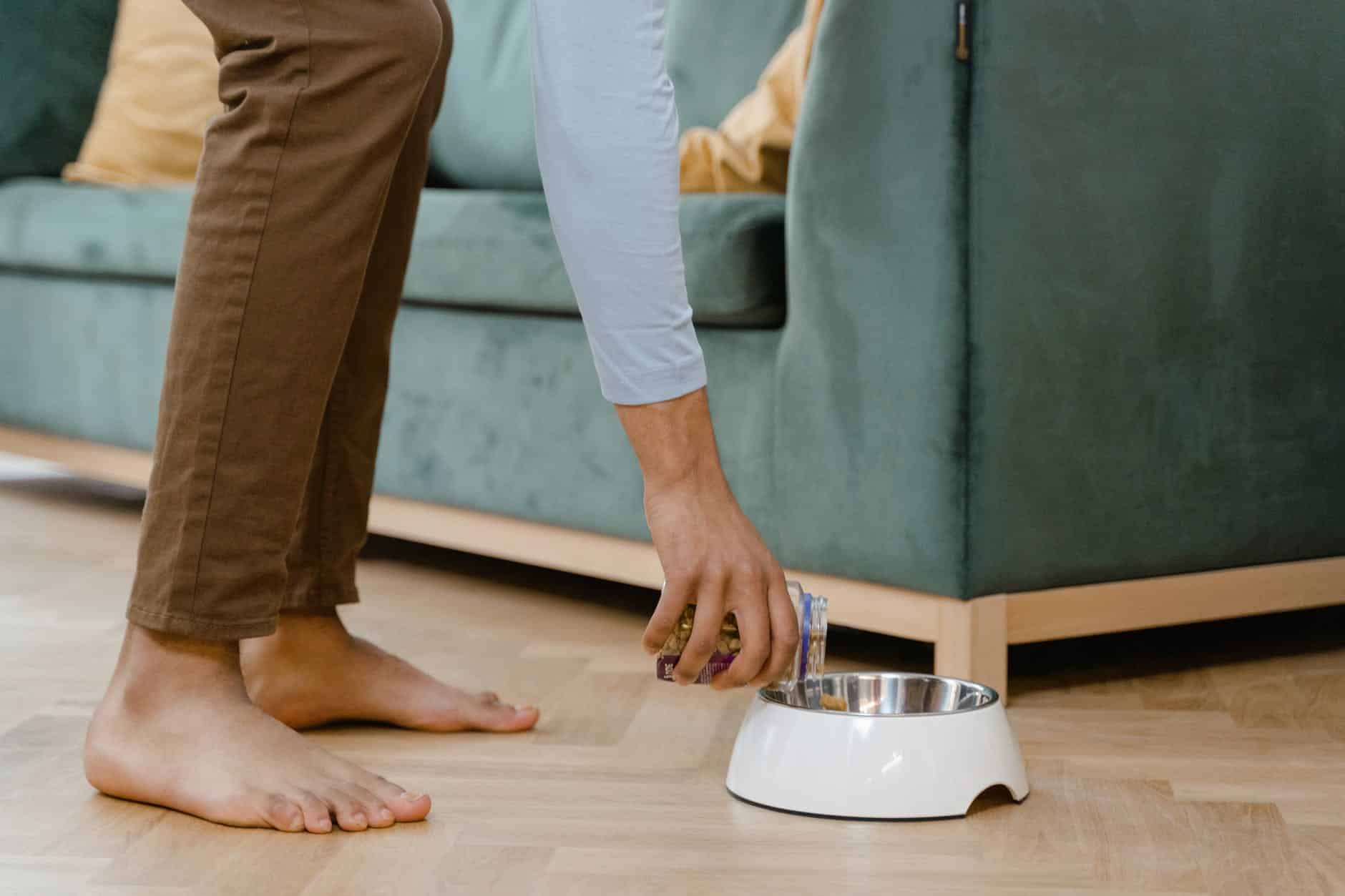
Using a Scale to Measure Dog Food
As an avid baker and home cook, I know that weighing flour, sugar, and butter is the only way to create truly consistent and reliable results.
My famous chocolate chip cookie recipe (I wish I could share them with you through the screen, they are amazing) is all done on a kitchen scale.
170g of flour
150g of brown sugar
50g of white sugar
and so on.
Last week I was scooping massive amounts of kibble into bowls for my Danes and got an idea to weigh it out, instead.
What I found, shocked me.
Both my eyeball measurement and my cup-by-cup measurements resulted in significantly more food in the bowl for my dog than when I measured the food on a scale.
As in, I have been way overfeeding my dogs…and you probably are too!
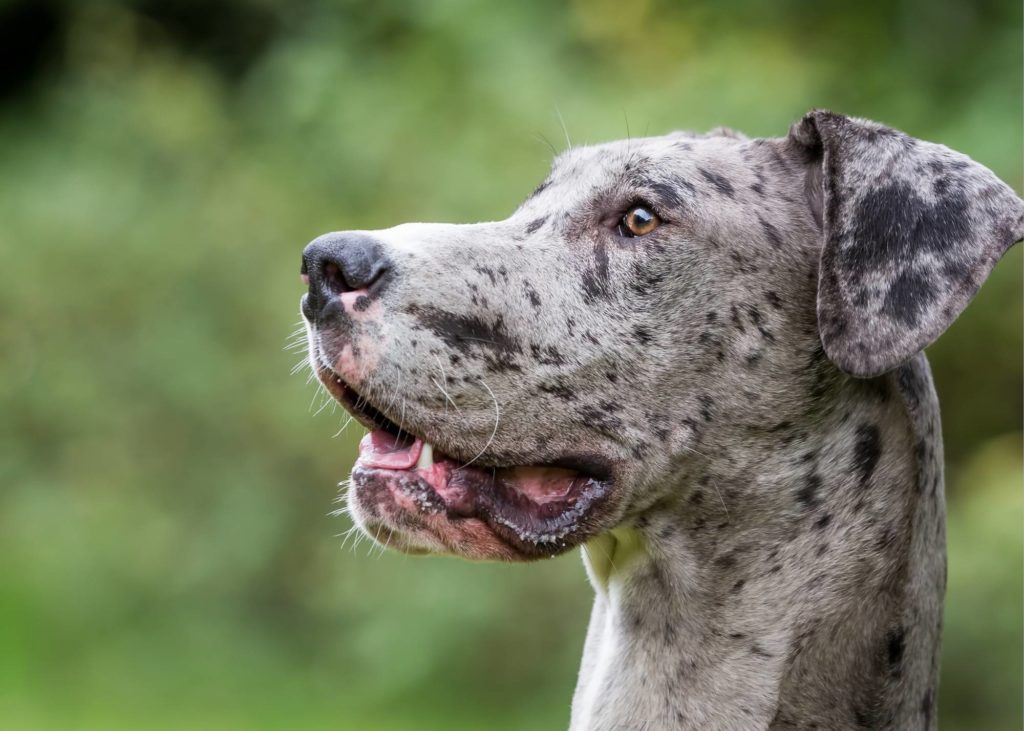
The Experiment
I used two popular types of large/giant breed kibble for this.
Purina Pro Plan Large Breed Adult Shredded Chicken
For each one, I documented the information from the food bag regarding how many grams were in a cup of the food, and how many kilocalories were in a cup as well.
I took two measurements of each food:
First: I scooped out a cup using a 1 cup measure, as most of us do, and I weighed it on a food scale.
Second: I used the scale to measure out exactly one cup of food by weight/grams (according to the data from the bag).
Then I compared the two results.
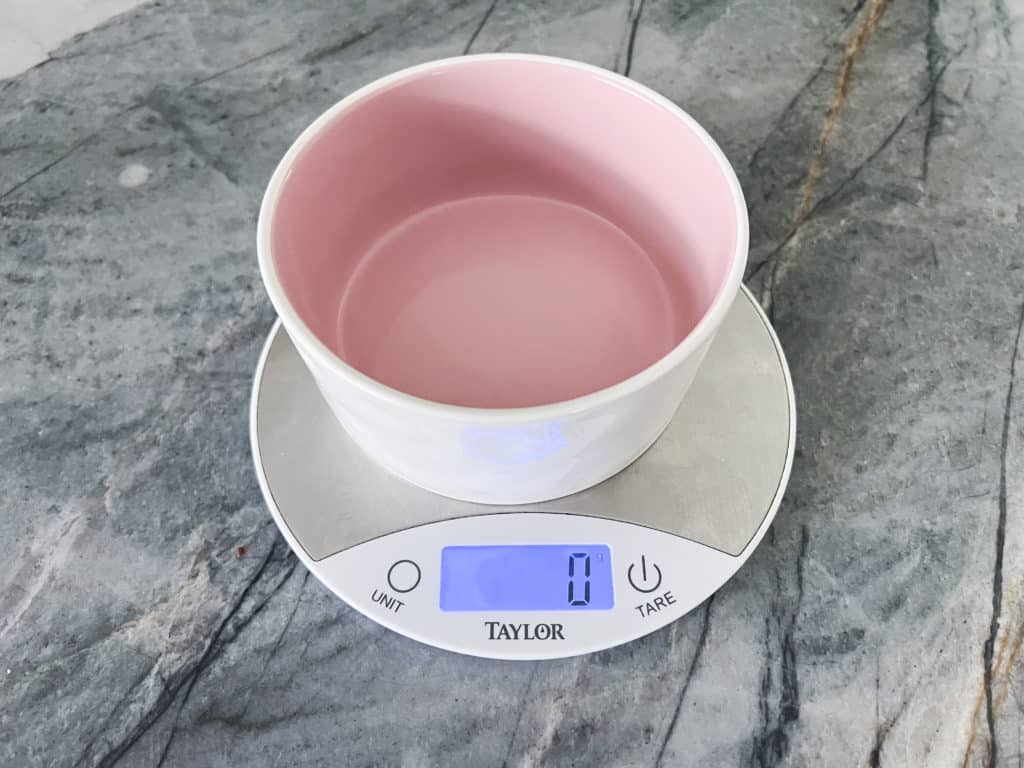
Royal Canin Giant Breed
This kibble has LARGE pieces!
According to the feeding chart on the bag, my 2-year-old moderately active Great Dane should have 5.5 cups of food each day.
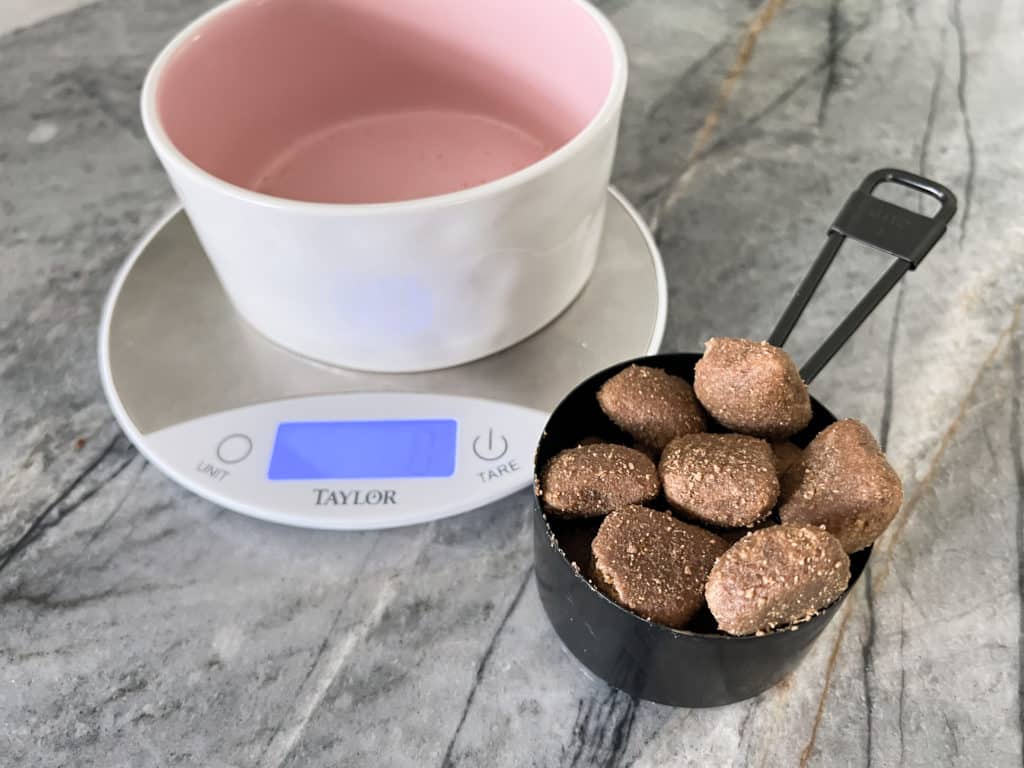
Scooped out and slightly full to make up for the airy space between kibbles.
Royal Canin says (on the bag) that the Giant Breed Adult food contains:
108G per 1 Cup. (Thus, 5.5 cups = 594g of food/day)
I scooped up a single cup of the nuggets the way that most of us tend to do it: a loose scoop with some pieces sticking out (because they are huge and left lots of air between pieces). I weighed them in an empty bowl on the scale.
The result? 130 grams. Not 108 grams, as a true cup of this should weigh.
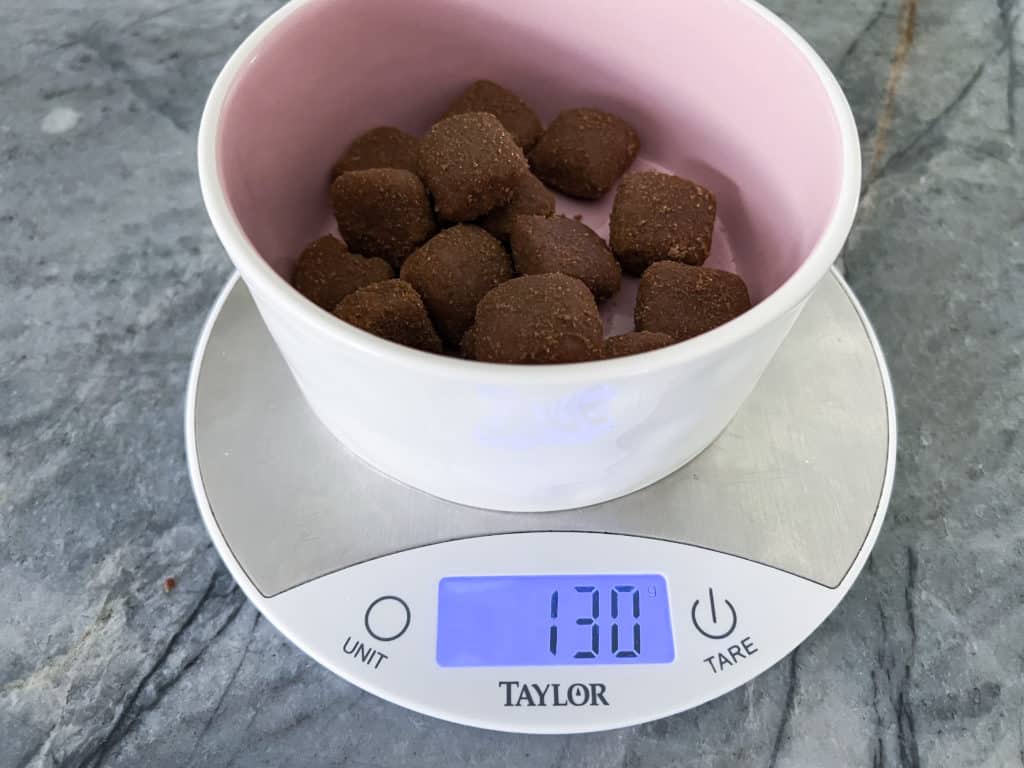
Meaning that my single sloppy cup measure was adding 22 EXTRA grams of the food.
That was just one cup, not all 5. Now, it stands to reason that this is going to ADD UP quickly. ?
For a dog that should be eating 5.5 cups, that could mean roughly 120 extra grams of food PER DAY!
120 grams is a whole bonus extra cup of food, in other words. Which, considering that a cup is around 1/5th of the dog’s daily intake requirement, that’s a LOT.
Not only that, but over the course of the week, my dog would be receiving 7-8 additional cups of calorie-dense food that they likely don’t even need.
That is more than an entire day’s worth of nutrition added to their weekly diet.
8 days of food in 7 days. ??
Have you ever wondered why there are so many obese dogs? We’ve just found a major clue…
The Best Foods For Great Danes
7 Deadly Health Risks for Overweight Dogs
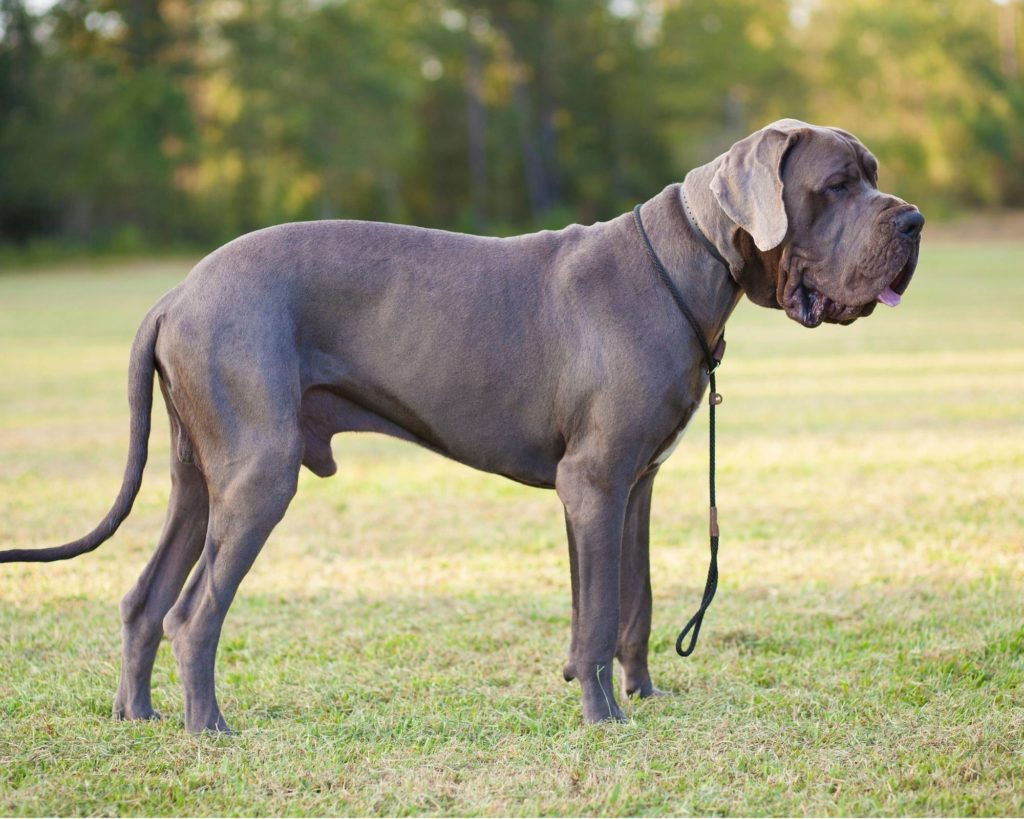
Purina Pro Plan Large Breed Shredded Chicken
For fun, I did this with a second food.
1 cup of Pro Plan Large Breed Shredded Chicken kibble should weigh 96 grams.
I used a measuring cup to pull a scoop out of the bag, taking care to not overfill it.
Then I weighed it on the scale and…don’t be surprised here, folks:
110 grams!
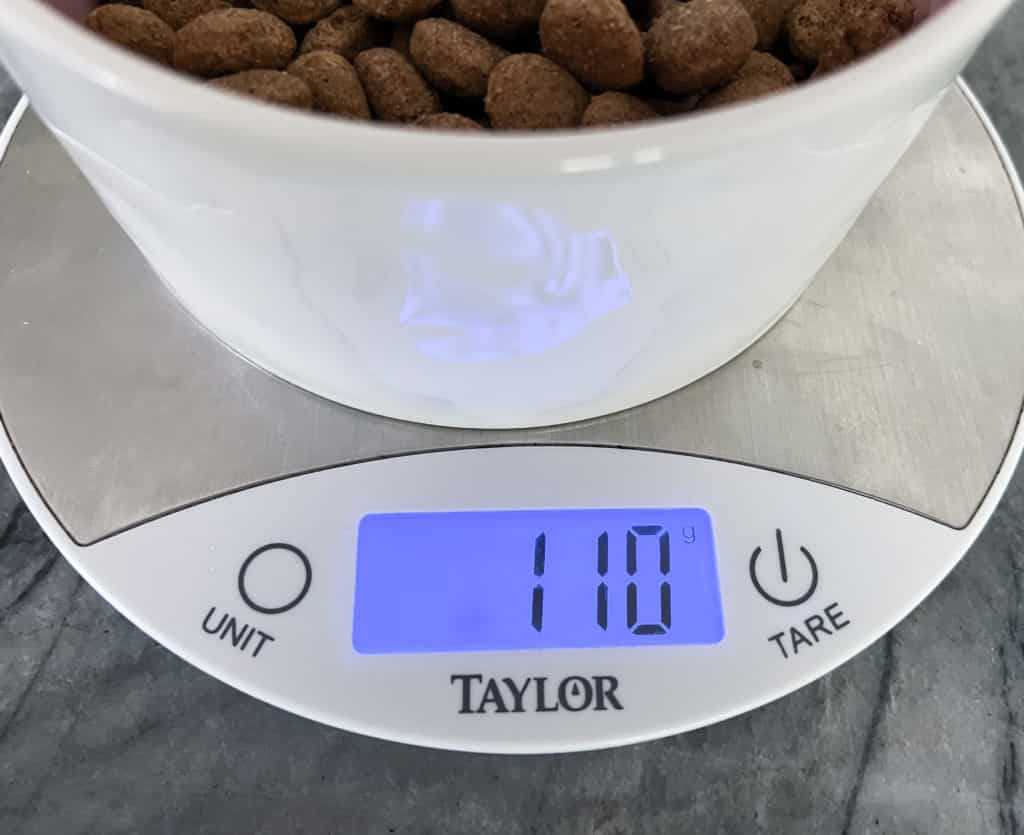
This means that every cup I scoop is receiving (average) 14 additional grams of the food.
For a dog that should receive 6 cups of Pro Plan, that could mean that they are being overfed by 84 grams each day.
Just like the Royal Canin, an 84-gram daily overage (almost a full cup of food) amounts to roughly 6-7 additional cups of food each week that the dog likely doesn’t actually need.
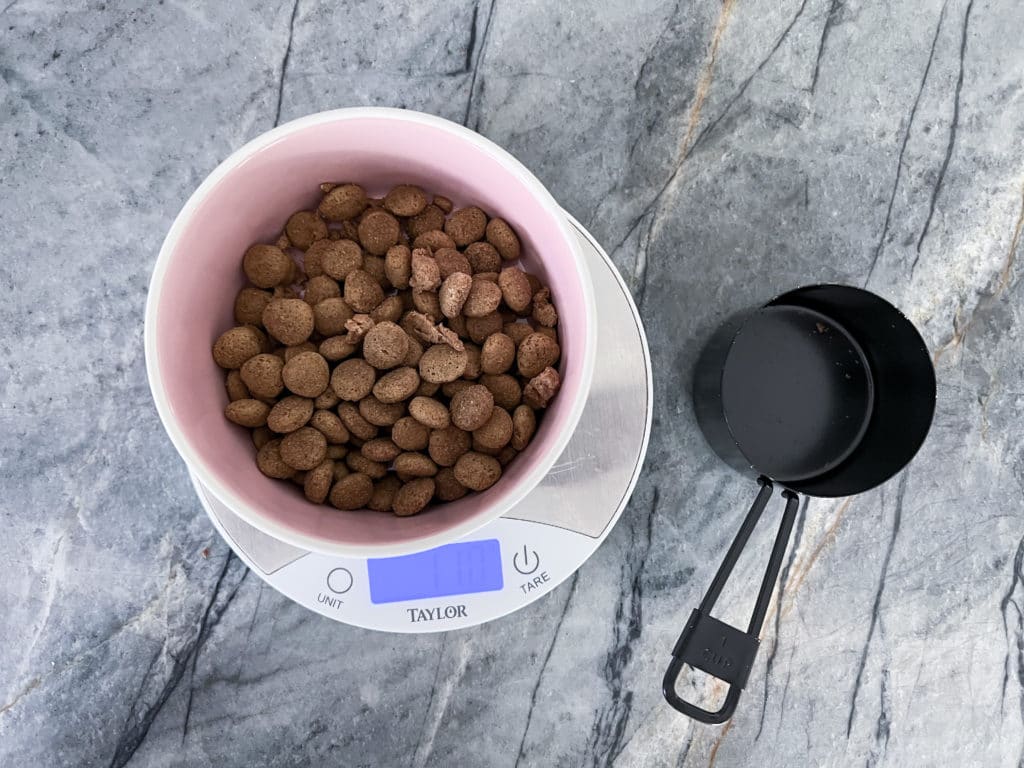
The Problems with Overfeeding Dogs
When we overfeed our dogs, we are not loving them. We are slowly killing them.
We are shortening their life spans, and making them more likely to suffer from a myriad of health problems, including:
Cancer
High Blood Pressure
Diabetes Mellitus & Pancreatitis (inflammation of the pancreas)
‘Allergies’ and ongoing loose stools
I’ve outlined some common ones below!
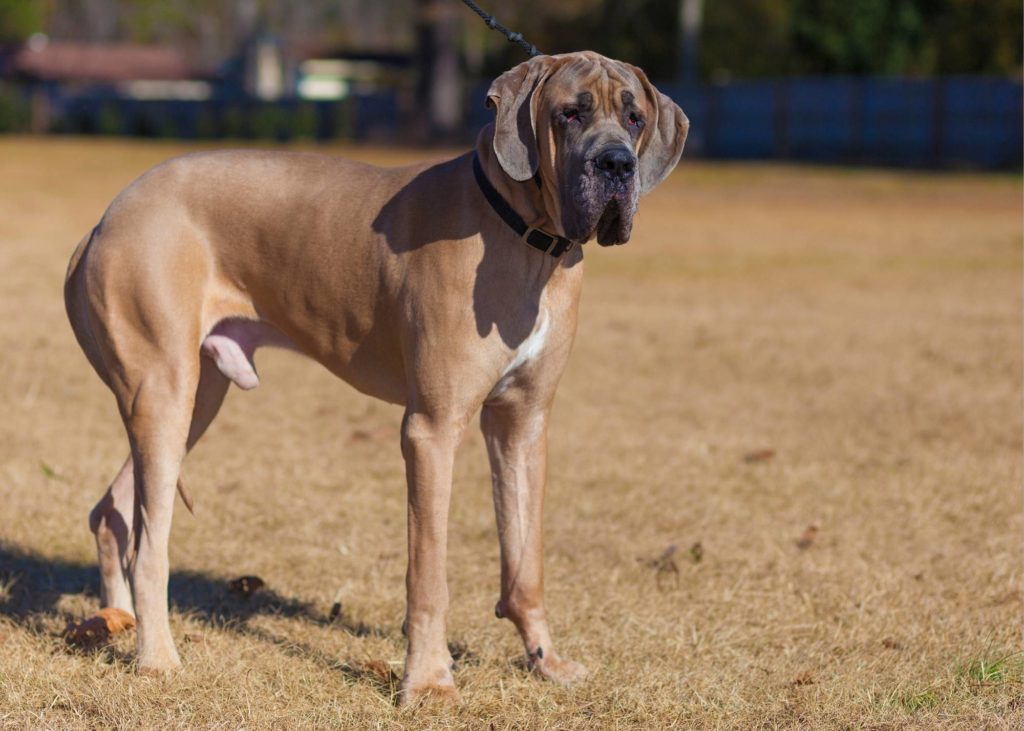
Chronic Loose Stools
Chronic loose stools are a common symptom of overfeeding in Great Danes! When you provide too much nutrition or unbalanced nutrition, it literally goes straight through them.
A lot of people misdiagnose chronic loose stools as ‘food allergies’ or ‘chicken intolerance’, however, most of the time these are actually related to poor gut health, too much food switching, unbalanced boutique dog foods and you guessed it, overfeeding!
Veterinarians across the Country cite a massive increase in health problems in dogs, including loose stools, heart problems, and low energy that they attribute to the popularity of untested, poorly formulated boutique dog foods.
Choose a well-balanced large or giant breed kibble instead, measure the food, and stick with it.
I recommend the following formulas, which are heavily researched and thoroughly tested, for large and giant breed dogs:
- Purina Pro Plan Large Breed Puppy – any flavor!
- Purina Pro Plan Sensitive Skin & Stomach Large Breed puppy – TOP PICK, salmon-based
- Eukanuba Large Breed Puppy (Great for active and sporting dogs)
- Purina One Large Breed Puppy (Excellent budget option)
- Hill’s Science Diet Puppy Large Breed
- Royal Canin Giant Puppy Dry Dog food (to age 12 months) – TOP PICK, PREMIUM OPTION
- Royal Canin Giant Junior Dry Dog food (8-24 months)
- Purina Large Breed Puppy Chow
Check out THE GIANT DOG FOOD PROJECT to compare brands and values.
- Purina Pro Plan Sensitive Skin and Stomach Large Breed (Salmon based, chicken free)
- Purina Pro Plan Large Breed Shredded Chicken & Rice (Large Pieces & Chicken Shreds!)
- Purina Pro Plan Large Breed Weight Management (Get the weight off)
- Purina Pro Plan Large Breed Bright Mind Age 7+ (for Senior Great Danes)
- Purina Pro Plan Giant Breed (Hard to find, might be discontinued)
- Royal Canin Giant Breed (Amazing for dogs with chronic loose stools, TOP TIER)
- Eukanuba Large Breed (Great for active and sport dogs)
- Purina One Smart Blend Large Breed (Fantastic budget-friendly option)
- Hill’s Science Diet Large Breed Beef & Rice
- Purina Pro Plan 30/20 Sport Beef & Bison
Obesity in Dogs
Weight gain is common, especially following spay or neuter surgery (which causes your dog’s metabolism to decrease).
Allowing your dog to pack on the pounds can shorten its lifespan, on average, by about 2 years!
Being a stocky, oversized ‘Euro’ Great Dane is no excuse for being overweight and heavy, either.
Great Danes are a lean, muscular, athletic breed and it’s important, for their health and well-being, that we honor that.
We’ve included some dog weight loss tips below, as well as the following resources:
Is my Dog Filling Out or Getting Fat?
Should I feed Grain-Free Food?
The Health Risks of Obesity in Dogs
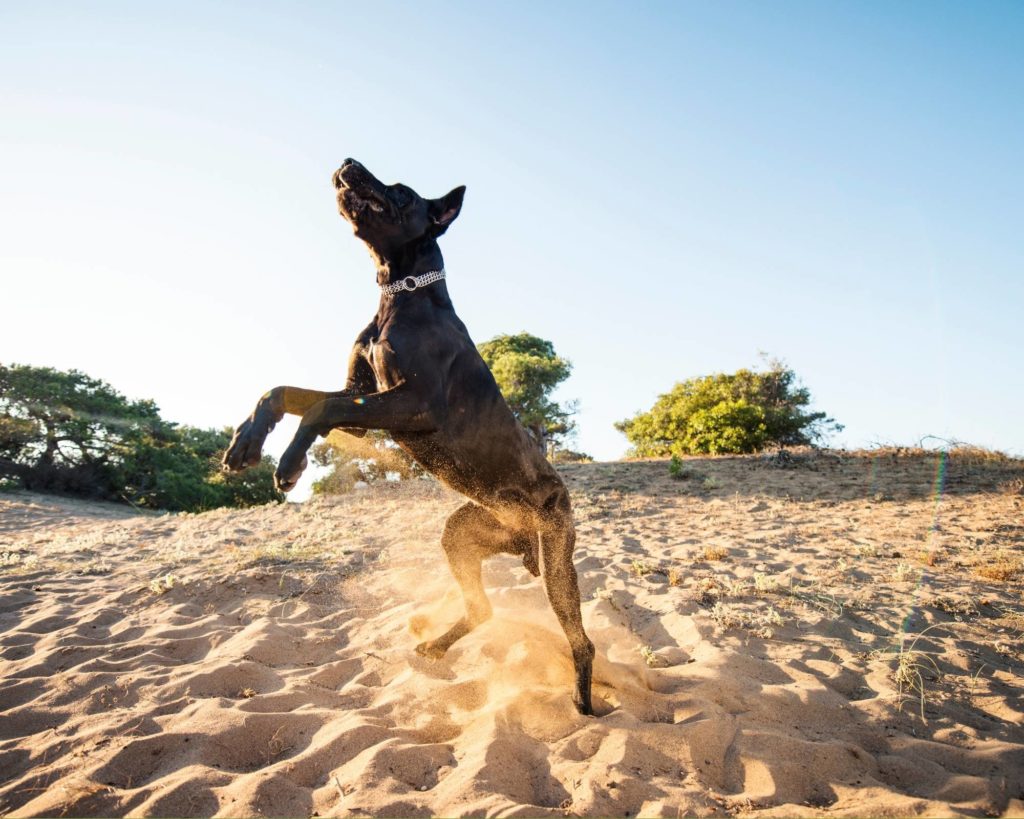
Over-nutrition and Growth Disorders
Growth disorders such as Pano (aka growing pains), HOD, flat feet, and knuckling are a direct result of over-nutrition, especially when feeding incorrect, unbalanced foods that have too much calcium or missing nutrients.
Great Dane puppies, especially young ones, require a LOT of food and for many reasons, we recommend feeding young dogs on a loose free-feeding schedule so that they aren’t underfed. However, as they mature, you should transition to a 2-3x/day feeding schedule.
You can learn more about this in our Ultimate Great Dane Feeding Chart post!
Feeding too much of the wrong thing can and will harm them.
We’ve included a list below of the only appropriate foods to feed a large or giant breed puppy, as well as some resources for understanding why those foods are highly recommended!
What are WSAVA Guidelines for Dog Food, and Do They Matter?
What is Ingredient Splitting in Dog Food?
Is Life’s Abundance a Good Food For My Dog?
- Purina Pro Plan Large Breed Puppy – any flavor!
- Purina Pro Plan Sensitive Skin & Stomach Large Breed puppy – TOP PICK, salmon-based
- Eukanuba Large Breed Puppy (Great for active and sporting dogs)
- Purina One Large Breed Puppy (Excellent budget option)
- Hill’s Science Diet Puppy Large Breed
- Royal Canin Giant Puppy Dry Dog food (to age 12 months) – TOP PICK, PREMIUM OPTION
- Royal Canin Giant Junior Dry Dog food (8-24 months)
- Purina Large Breed Puppy Chow
Check out THE GIANT DOG FOOD PROJECT to compare brands and values.
Pickiness
Many Great Dane owners believe that their dogs have become picky because they are turning their noses up at their food.
These dogs are most often actually just FULL!
In the interest of getting them to eat more, people tend to switch foods and start adding toppers and other forms of nutritional bribery.
The dog learns that if they ignore their food, interesting and fun things come to them.
“Picky eating” is a bit of a popular myth that is literally caused by humans! It’s ok for a dog to not eat their entire meal.
Picky dogs are not usually picky, they are literally just training you to give them treats. Many picky dogs are actually overweight and need less food, not more!
A healthy dog will not let itself starve to death, and if it does? Switching foods isn’t going to help. That’s a dog that needs medical attention.
Is Gentle Giants a Good Dog Food?
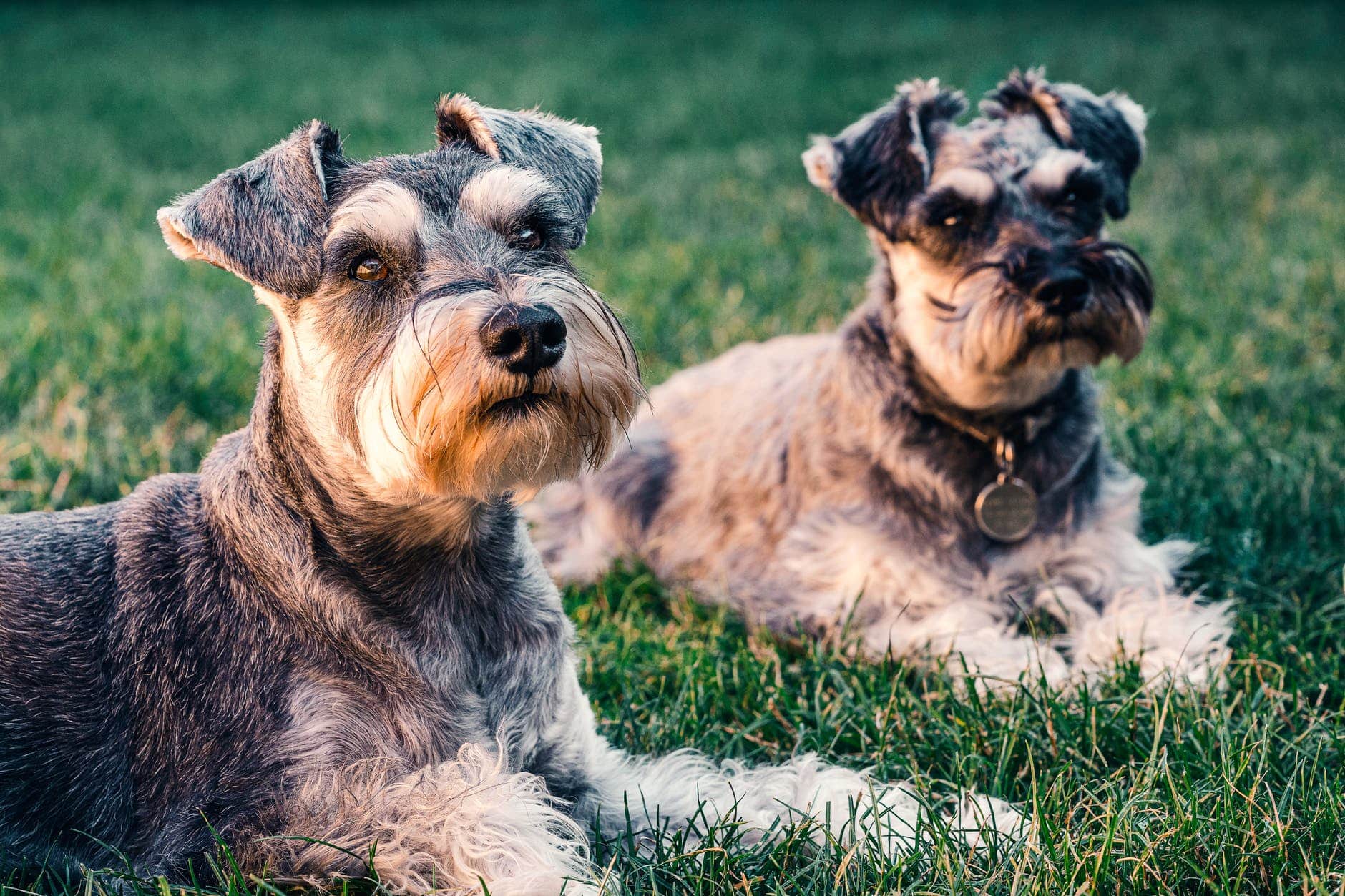
‘Allergies’
Once a dog has been sent down the path of ‘picky eating’ where different kibble brands are changed often and treats and toppers are added to encourage eating, their gut health suffers.
Poor gut health also means being intolerant to the environment and yes, symptoms may then show up indicating that the dog has allergies.
These symptoms include loose stools, a dry coat, and itching.
Dogs with lighter coats may be more prone, and some dogs will continue to suffer from environmental allergies no matter what (just like humans). It’s important to set all dogs up for success!
Some allergies are legitimate and life-threatening to dogs. The ONLY way to diagnose these types of allergies in dogs is to complete a food-trial elimination diet with veterinary supervision.
Legitimately diagnosed food protein and grain allergies are extremely rare. It’s important to note that blood and saliva tests are inaccurate and often a waste of money.
Most dogs suffering from allergies are actually experiencing intolerance to environmental allergens, not food!
PRO TIP: Use a wet towel to gently wipe dander and pollen off your pup daily, and wash their feet to remove irritants.
Many health issues like this are made worse by constant food switching and the use of untested, poorly formulated boutique diets that lack the correct balance of micro-nutrients and amino acids.
Stop food switching to “find something that works”, measure the food, and let your dog’s gut health heal!
We highly recommend Olewo Carrots and Olewo Beets for added fiber and to soothe the tummy, in addition to Fortiflora or Probios Probiotics.
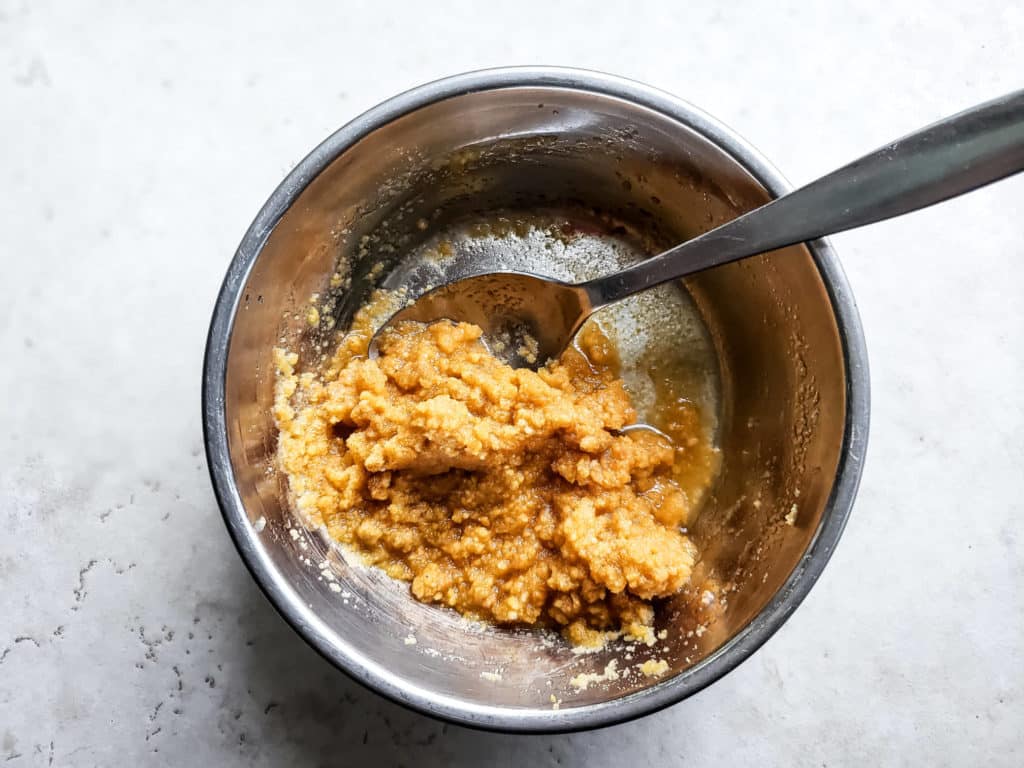
Weight Loss Tips for Great Danes
If your dog needs to lose weight, there are things you can do!
Vet check? Check!
If you are concerned about your dog’s weight, it’s important to ask your veterinarian for advice!
Some dogs have weight problems because of thyroid issues or other medical conditions that can be easily managed with medication or a change in diet.
Be sure to rule out any possible underlying health issues, including heart problems and thyroid disease, before starting a weight loss plan for your dog.
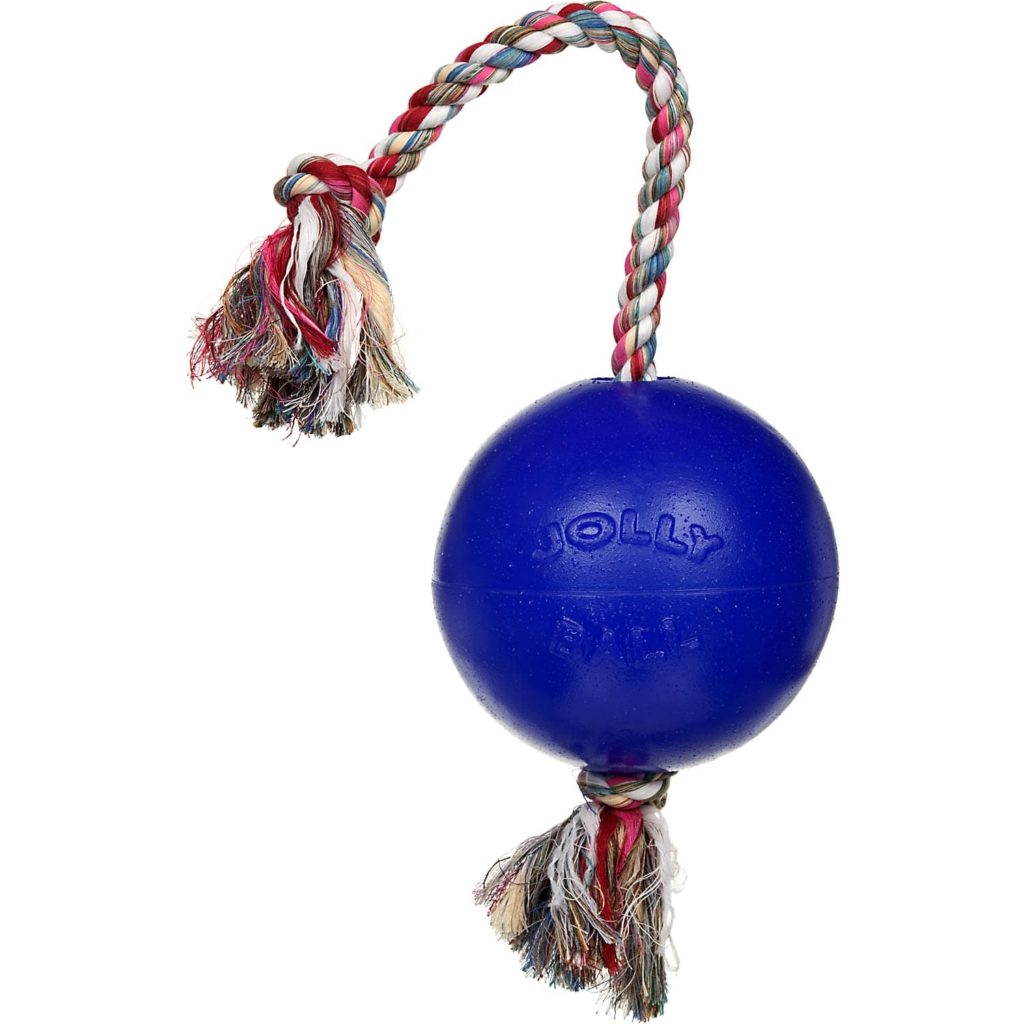
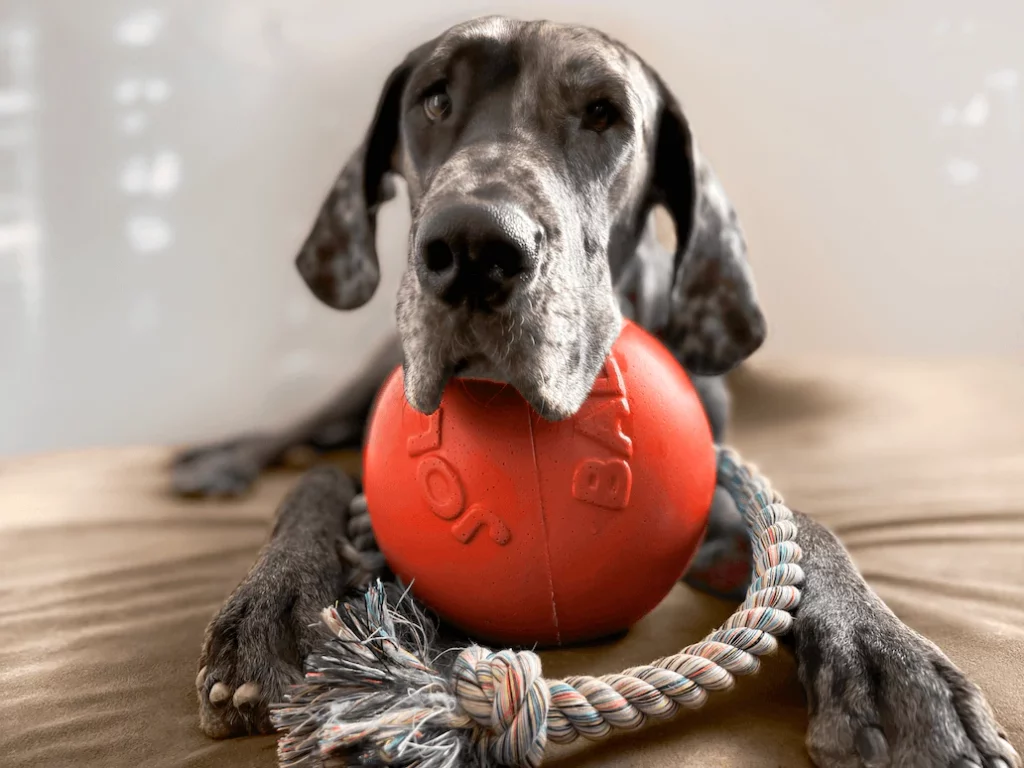
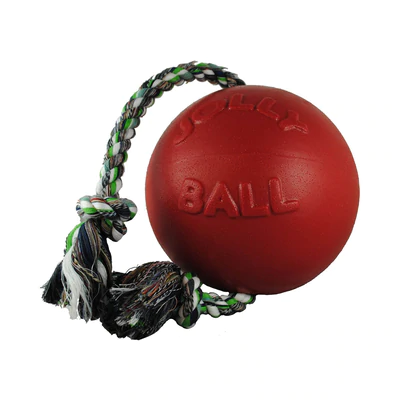
Change the diet
The one time we DO recommend a diet change is when you are not feeding quality food, and when your dog needs to lose weight. The following weight loss formula is recommended for at-home use:
Pro Plan Adult Weight Management Large Breed Chicken & Rice Formula
Your veterinarian may also be able to prescribe a diet from Hill’s or Royal Canin that will help your pooch cut the calories. Royal Canin has put together an amazing healthy-weight resource page for dog owners:
https://www.royalcanin.com/us/dogs/products/weight
Measure the food on a scale so that you don’t overfeed!
Be aware of the fact that many boutique foods use ingredient splitting to make you believe their food is ‘meat first’, when the truth is you may be feeding your dog an expensive bag of ‘human grade peas’.
It’s no wonder so many dogs are overweight and struggling with low energy!
DCM in Dogs: What You Need to Know
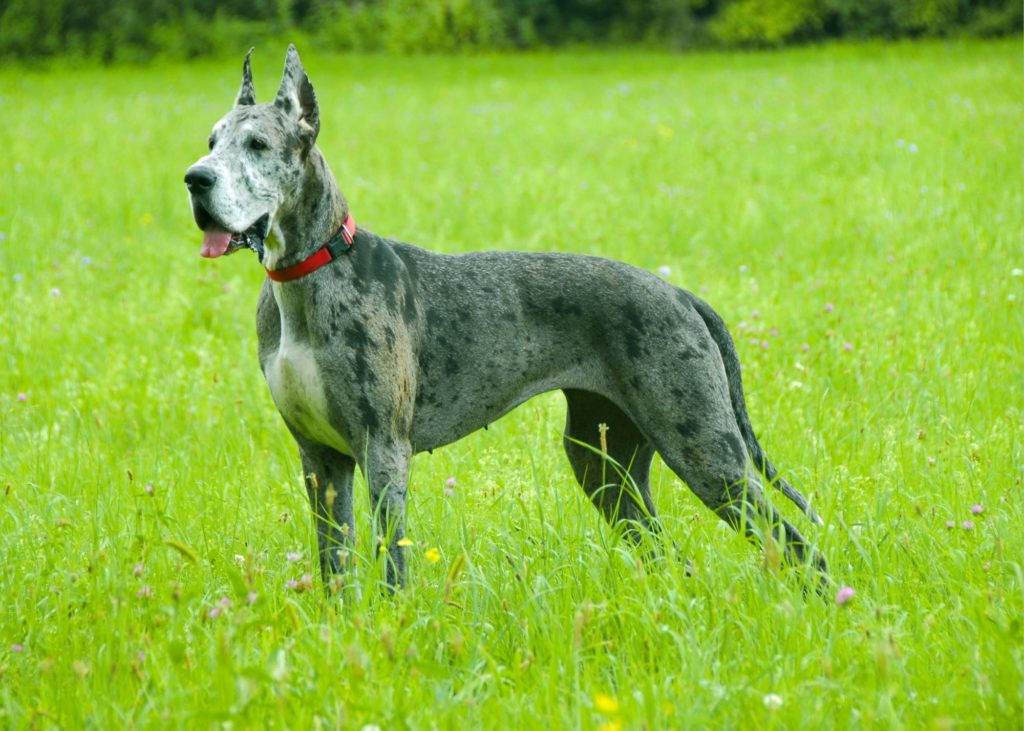
Tread cautiously with toppers
Toppers and treats can help your dog or they can hurt them.
Too many can lead to over-nutrition (and thus, obesity).
Some people say to add green beans or pumpkin to your dog’s bowl to offset some calories; while this can help your dog feel more full, it’s important to keep these toppers to 10% or less of the diet.
We recommend well-balanced raw food as a healthy, fresh-foods topper.
Olewo Carrots, Olewo Beets, and Dr. Harvey’s are also fantastic choices for adding wholesome fibers to your dog’s diet; as above, keep these to 5-10% or less of the diet.
Pro Tip: A little goes a long way! If you are helping your dog lose weight, take it easy on the Dr. Harvey’s.
Get ready to move…naturally
An off-leash dog can burn up to 300 calories in an hour!
That’s a significant amount! We recommend off-leash training for all large and giant breed dogs, including Great Danes.
This will allow them to zip, zoom, run, spin, explore and gain enrichment and physical movement that they are not receiving on a leash, long-line, or in a harness.
With this kind of activity, your dog will be building muscle, shedding fat, and working its brain!
Many dogs will benefit greatly from receiving their exercise and enrichment this way, however, you must be smart about it.
Dogs that are extremely aggressive, fearful, timid, or wild need professional help with this, and you should never let your dog off-leash unless you can fully rely on them not to approach people and dogs uninvited.
E-Collar training and educated ownership is the best way to give your dog this freedom of movement outside of your fenced yard.
If this isn’t for you, it’s still important to get your dog moving! Talk to your veterinarian about physical therapy, including the use of water treadmills and pools to help your dog burn calories.
READ MORE:

